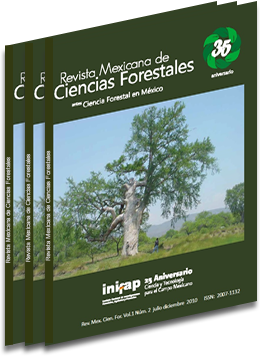PINE SEEDLING INOCULATION WITH DIFFERENT FUNGI AND VISUAL IDENTIFICATION OF ECTOMYCORRHIZAE
DOI:
https://doi.org/10.29298/rmcf.v1i2.637Keywords:
Ectomycorrhizae, visual identification, Pinus devoniana, Pinus pseudostrobus, Pisolithus, SclerodermaAbstract
From the urgent need for reforestation of large areas of our country and to find out microorganisms able to stimulate the growth of pines, this study was conducted using a practical inoculation method to allow an easy recognition of ectomycorrhizal colonization by nursery workers. Pinus devoniana and P. pseudostrobus were the tree species used in this experiment. The ectmycorrhizal fungi were Pisolithus tinctorius 202 (a Spanish isolate), P. tinctorius (PHC) and Scleroderma texense (native fungus). Identification of fungi based on form and color was easy. Six months after the inoculation the three fungi showed good root colonization; they formed visible external mycelium in both pine species tested. Under the assayed conditions Scleroderma texense appeared as a good root colonizer. At this early stage of growth the dry weight of both P. devoniana and P. pseudostrobus treated with S. texense was significantly different compared to control plants (p< 0.05); with no statistical differences on volume. After 18 months of inoculation, statistical analysis indicated that the volume of Pinus devoniana inoculated with P. tinctorius 2002 was significantly higher compared to other treatments; plants treated with P. tinctorius 202 and with S. texense were different to P tinctorius (commercial strain) in terms of dry matter of the plant. In this stage of seedling growth, root colonization was no longer dominated by S.texense; roots were also colonized by other fungi occurring in the nursery soil.
Downloads
Downloads
Published
How to Cite
Issue
Section
License
The authors who publish in Revista Mexicana de Ciencias Forestales accept the following conditions:
In accordance with copyright laws, Revista Mexicana de Ciencias Forestales recognizes and respects the authors’ moral right and ownership of property rights which will be transferred to the journal for dissemination in open access.
All the texts published by Revista Mexicana de Ciencias Forestales –with no exception– are distributed under a Creative Commons License Attribution-NonCommercial 4.0 International (CC BY-NC 4.0), which allows third parties to use the publication as long as the work’s authorship and its first publication in this journal are mentioned
The author(s) can enter into independent and additional contractual agreements for the nonexclusive distribution of the version of the article published in Revista Mexicana de Ciencias Forestales (for example, include it into an institutional repository or publish it in a book) as long as it is clearly and explicitly indicated that the work was published for the first time in Revista Mexicana de Ciencias Forestales.
For all the above, the authors shall send the form of Letter-transfer of Property Rights for the first publication duly filled in and signed by the author(s). This form must be sent as a PDF file to: ciencia.forestal2@inifap.gob.mx
This work is licensed under a Creative Commons Attribution-Noncommercial 4.0 International license.







